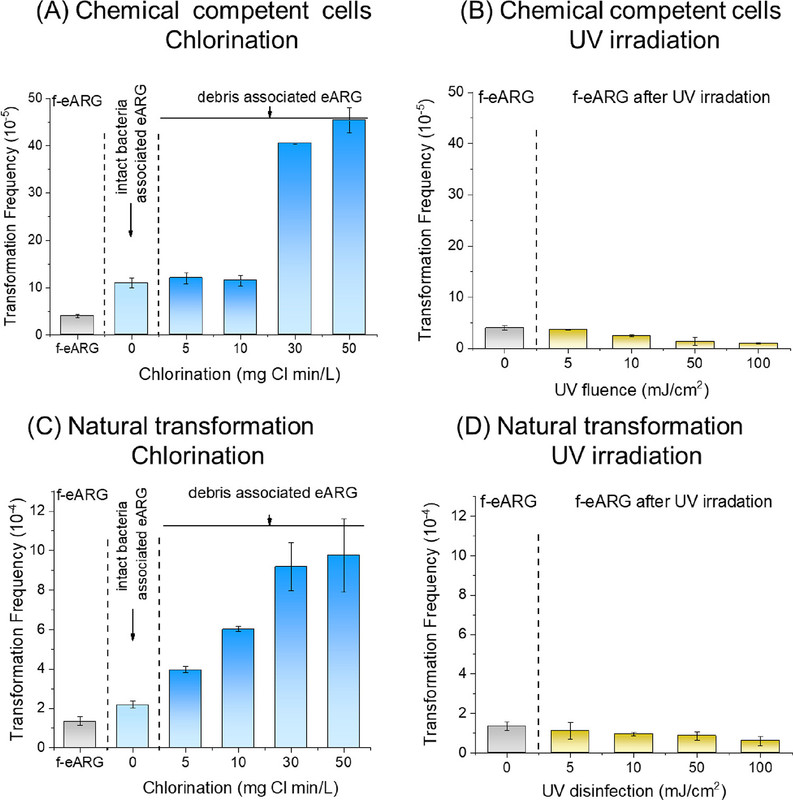Science
Related: About this forumChlorination, but not UV radiation, facilitates the transfer of antibiotic resistance genes...
...during wastewater treatment.
Regrettably, I won't be able to spend a lot of time on this note; I'm behind on many things, but it struck me as interesting.
The paper to which I'll refer is this one: Chlorination (but Not UV Disinfection) Generates Cell Debris that Increases Extracellular Antibiotic Resistance Gene Transfer via Proximal Adsorption to Recipients and Upregulated Transformation Genes Qingbin Yuan, Pingfeng Yu, Yuan Cheng, Pengxiao Zuo, Yisi Xu, Yuxiao Cui, Yi Luo, and Pedro J. J. Alvarez Environmental Science & Technology 2022 56 (23), 17166-17176.
From the introduction to the paper:
Chlorination and ultraviolet (UV) irradiation are the most common secondary effluent disinfection processes in most countries. (8) Both approaches are generally efficient for killing bacteria but not for removing ARGs since intracellular ARGs (iARGs) are mainly released as eARGs into the environment rather than destroyed after cell lysis. (3) Furthermore, disinfection generates bacterial debris from cell lysis (4,9) that free eARGs may adsorb to, forming adsorbed eARGs. (4) Previous studies showed that microplastic-adsorbed eARGs could have a higher transmission potential than free eARGs by facilitating proximal eARG–recipient adsorption. (10) However, little is known about the influence of different disinfection strategies and associated byproducts, specifically bacterial debris, on eARG physical states (e.g., free or adsorbed ARG) and their dissemination potential.
Chlorination can generate oxidized bacterial debris with altered affinities for eARGs due to changes in the surface charge and hydrophobicity (11) caused by the chlorinated lipids and amino acids. (12) In contrast, UV irradiation kills bacteria mainly by destroying DNA (13) without substantially affecting the cell integrity. Disinfection by chlorination can also generate environmentally persistent reactive oxidative species (e.g., chlorinated radicals) (14) or chlorinated organics (15) that could influence the susceptibility of some bacteria to transformation by eARGs. (16) Thus, different disinfection methods produce bacterial debris with distinct properties that may interact with eARGs differently and have consequences on eARG persistence and transmissivity.
This study compares the effects of chlorination versus UV irradiation on WWTP effluent in terms of eARG abundance, transformation, and persistence. E. coli with a blaNDM-1 multi-drug resistance gene (coding metallo-β-lactamase) was used as a model multidrug-resistant enteric bacterium. The importance of eARG adsorption onto cell debris for enhanced transformation was assessed separately using the competent reference strain E. coli HB101 or the natural competent strain Vibrio vulnificus (V. vulnificus) as the recipient. Notably, V. vulnificus is an important opportunistic human pathogen frequently detected in wastewater, freshwater, and marine environments. (17−19)...
I am not an expert in genomics, but I'm trying to learn as much as I can about the subject when time permits.
The paper is cool, since it evoked a concept in the physical chemistry of colloids featuring charged species of which I was unaware, Derjaguin–Landau–Verwey–Overbeek theory. (Nucleic acids are charged species.)
Anyway, it appears that by causing cells to break up, chlorination releases antibiotic resistance genes that can conjugate with other bacteria to induce antibiotic resistance in that species.
Radiation is different inasmuch it destroys DNA completely. (I'm a radiation kind of guy; although ultimately I'd like to see wastewater processed by supercritical water oxidation, SWO, since this technology tends to destroy otherwise persistent organic pollutants, an increasingly serious environmental issue).
Two graphics from the paper:

The caption:

The caption:
Figure 3. Chlorination-produced adsorbed eARGs exhibited a higher transformation frequency than that of free eARGs. (A) Transformation frequency of f-eARG and a-eARG associated with bacterial debris produced by chlorination at various doses by reference strain E. coli HB101. (B) Transformation frequency of f-eARG after exposure to UV irradiation at various fluences by reference strain E. coli HB101. (C) Transformation frequency of f-eARG and a-eARG associated with bacterial debris produced by chlorination at various doses by natural competent strain V. vulnificus. (D) Transformation frequency of f-eARG after exposure to UV irradiation at various fluences by natural competent strain V. vulnificus.
From the conclusion:
Wastewater disinfection is an important practice to mitigate the spread of waterborne infectious diseases and control the potential release of antibiotic-resistant pathogens. However, an overlooked unintended consequence of chlorination, which is the dominant effluent disinfection process, (47) is the release eARGs that are predominantly adsorbed to the generated cell debris. This debris has high affinity to both eARGs and recipient bacteria, enhancing opportunities for their effective collision and resulting transformation. Chlorination also produces persistent free radicals and chlorinated molecules on the cell debris that contribute to upregulation of transformation-related genes and further facilitate the horizontal transfer of the adsorbed eARGs. This combination of the active surface area for proximal adsorption of transforming eDNA and recipient cells and generating transformation-enhancing substrates could lead to an enrichment of the environmental resistome even in the absence of antibiotics. In contrast, disinfection by UV irradiation releases mainly free (possibly damaged) eARGs with a significantly lower transformation potential.
Overall, eARGs adsorbed to bacterial debris generated by chlorination is likely to experience higher persistence and a higher propagation potential than free eARGs in receiving waters. However, further studies at larger temporal and spatial scales are needed to determine whether this effect contributes significantly to resistome dissemination.
We have radiation sources available to us at essentially low energy and environmental cost, should we ever lose our irrational fear and ignorance associated with the topic. That hasn't happened yet, but hopefully it will.
I wish you a successful, rewarding, and life affirming New Year.
Turbineguy
(38,958 posts)Tertiary effluent ponds that are open to sunlight produce fewer ARGs.(?)
moniss
(7,048 posts)I would add another aspect to the subject. Regardless of the treatment method of wastewater there is always the aspect of post discharge impacts on organisms exposed to the treated wastewater. We cannot assume they would be the same or a lesser impact without studies.